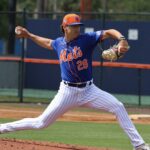Whether you see the 2011 Mets as team that is in rebuild mode or one only a few changes away from a playoff contender, one thing remains absolutely certain and that is the need to bolster the rotation with an effective and reliable starting pitcher.
With the odds of landing Cliff Lee or Zach Grienke fading fast, and a barren free agent crop this hot stove season, our new GM Sandy Alderson will have to be creative if the Mets are going to join the arms race.
There are enough reports circulating that the Tampa Bay Rays will most likely deal one of their starters; either James Shields or Matt Garza. While both could help the Mets, my preference is Garza, who turns 27 later this month.
Take a look at the following chart:
Matt Garza
| Year | W | L | GS | IP | H | HR | BB | SO | |||
|---|---|---|---|---|---|---|---|---|---|---|---|
| 2008 | 11 | 9 | 3.70 | 30 | 184.2 | 170 | 19 | 59 | 128 | 1.240 | 2.17 |
| 2009 | 8 | 12 | 3.95 | 32 | 203.0 | 177 | 25 | 79 | 189 | 1.261 | 2.39 |
| 2010 | 15 | 10 | 3.91 | 32 | 204.2 | 193 | 28 | 63 | 150 | 1.251 | 2.38 |
When you look at Garza’s last three seasons, his WHIP and ERA are the first things that jump out at you. One other thing to take note of is the homeruns which I intentionally included in this chart to make one of my points later on.
An interesting comparison to make when you look at Matt Garza, is that of fellow 2005 first round draft pick, Mets righthander, Mike Pelfrey. Pelfrey was selected with the #9 overall pick, while the Twins selected Garza much later at #25. And while many Mets fans still hold out such high hope for Mike Pelfrey to improve, Garza has already proved to be the better and more consistent pitcher. The only things these two pitchers have in common is their age, and that they both have started 30+ games in the last three seasons. The similarities end there. Please observe.
Mike Pelfrey
| Year | W | L | GS | IP | H | HR | BB | SO | |||
|---|---|---|---|---|---|---|---|---|---|---|---|
| 2008 | 13 | 11 | 3.72 | 32 | 200.2 | 209 | 12 | 64 | 110 | 1.360 | 1.72 |
| 2009 | 10 | 12 | 5.03 | 31 | 184.1 | 213 | 18 | 66 | 107 | 1.514 | 1.62 |
| 2010 | 15 | 9 | 3.66 | 33 | 204.0 | 213 | 12 | 68 | 113 | 1.377 | 1.66 |
If you were to simply ignore the ERA for one moment, and focus on Pelfrey’s WHIP and SO/BB, you will see a dramatic difference in their performances over the last three seasons. As a sinker-baller, Pelfrey does not allow nearly as many homeruns as Garza, but he has been shielded by the vastness of Citi Field and Shea. I also stumbled upon some interesting data that would make one wonder if Garza would enjoy even more success pitching at Citi Field than even Mike Pelfrey, especially where allowing homeruns are concerned.
Lately I find myself delving more and more into statistics, and my research for this piece took me on a trip to Fangraphs. I went there because I wanted to compare Pelfrey and Garza’s flyball rates, but while I was there I found an added bonus that I was not expecting to see, and it led me to the creation of a new stat which I was going to name after the founder, me, but decided to cal it XFB% instead. I’ll explain that in a moment, but first let’s look at the following.
Career Flyball Percentage
Mike Pelfrey – 30.2%
Matt Garza – 37.6%
That difference may not seem like much, but over the course of 200 innings and facing 800 or more batters in an average season, the ripple effect can be very dramatic. Still, looking at Garza’s flyball rate, he should still be able to reduce his homeruns allowed by about 10-15%, or the equivalent of 3-5 homeruns less, by pitching half of his games at Citi Field.
But then I discovered IFFB%, which is the percentage of flyballs that stayed in the infield.
Career Infield Flyball Percentage
Mike Pelfrey – 8.0%
Matt Garza – 28.1%
Aha… I believe I may be on to something.
I decided to take both numbers and recalculate them to give us what I will call an Extreme Flyball Percentage or XFB%. This new metric will give you a flyball percentage that gives you the net difference between FB% and IFFB%. Or in simpler terms, the percentage of flyballs that were hit beyond the infield. Why did I feel the need to do that? I felt it would be give you a better indication of a pitchers propensity of allowing homeruns, than FB% alone would give you.
So I take each pitcher’s flyball percentage and multiply it by the inverse of their infield flyball percentage. For example, Pelfrey’s 30.2 FB% multiplied by .92 would give you a 27.78 extreme flyball percentage.
So lets take a look at how these two pitchers stack up now.
Extreme Flyball Percentage
Mike Pelfrey – 27.8%
Matt Garza – 27.1%
Maybe this statistical stuff isn’t so lame after all. Judging by my calculations, and of course this is based purely on a sample size of their five year major league careers, Matt Garza would most likely give up fewer homeruns pitching half of his games at Citi Field, than Mike Pelfrey would.
This of course would make a dramatic impact on Garza’s ERA which even now is better than Pelfrey’s over the last three seasons despite facing a designated hitter 3-4 times per start instead of the reprieve of the pitchers spot in the lineup.
Garza is arbitration eligible and should get a substantial raise over the $3.35MM salary he earned in 2010, and that’s exactly why the Rays will be looking to trade him, opening up a big opportunity for the Mets to get that solid arm they crave.
With the impending loss of Carl Crawford, the Rays will most likely seek to plug that hole in the outfield which would suggest a strong interest by them in arbitration eligible Angel Pagan. Finding a replacement for Pagan would be far easier than finding a pitcher like Matt Garza. For those of you flinching, the point of all trades is not to help just one self but to help both teams, that’s how deals get done. I read some ridiculous mentions of offering Lucas Duda for Garza which of course the Rays would simply laugh at.
Now I’m not convinced that Duda has shown me enough to suggest that he could be an everyday player in the major leagues. But if the majority of fans believe Duda is up for the task, and is so valuable that he would be the prize in a Matt Garza deal, than I guess you should have no problem keeping Duda and making him the right fielder on opening day when Matt Garza faces off against the Marlins on April 1st.
Get it done Sandy.
Note: There may already be a statistic that gives you the net difference between flyballs and infield flyballs. When I say I invented it, it was purely tongue in cheek.














